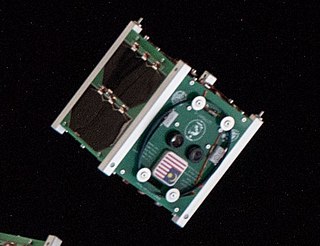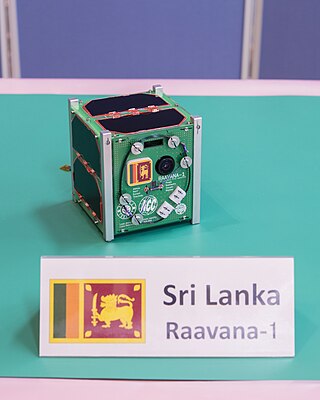
All Nations University was founded by Rev. Dr. Samuel Donkor in Ghana. It began with 37 students in October 2002 and has now expanded to over 2000 students. It became an accredited university college in Ghana in October 2002. The university is affiliated to Kwame Nkrumah University of Science and Technology and in collaboration with SRM Institute of Science and Technology (India). On May 28, 2020, All Nations was granted a presidential charter by the President of Ghana.

Nanoracks LLC is a private in-space services company which builds space hardware and in-space repurposing tools. The company also facilitates experiments and launches of CubeSats to Low Earth Orbit.

The Nanoracks CubeSat Deployer (NRCSD) is a device to deploy CubeSats into orbit from the International Space Station (ISS).

SpaceX CRS-11, also known as SpX-11, was a Commercial Resupply Service mission to the International Space Station, launched successfully on 3 June 2017. The mission was contracted by NASA and was flown by SpaceX. The mission utilized a Falcon 9 launch vehicle and was the first reuse of C106, a CRS Dragon cargo vessel that was previously flown on the CRS-4 mission.

GhanaSat-1 was the first Ghanaian nanosatellite to be launched into space. It was designed and built in two years in conjunction with the Kyushu Institute of Technology Birds-1 program, which has the goal of helping countries build their first satellite.

Mazaalai was a Mongolian nanosatellite CubeSat that was launched into space on 3 June 2017 as part of the SpaceX CRS-11 mission.

Nigeria EduSat-1 was a Nigerian nanosatellite built by the Federal University of Technology Akure (FUTA), created in conjunction with the Japanese Birds-1 program. It was Nigeria's first satellite built by a university. It was launched from the Japanese Kibō module of the International Space Station.

Birds-1 was the first iteration of a multinational program called the Joint Global Multi-Nations Birds Satellite project, or Birds project, to help countries build their first satellite. The Japanese Kyushu Institute of Technology (KIT) supported the design and fabrication of the satellites. The constellation was launched by a Falcon 9 rocket to the International Space Station on 3 June 2017, as part of CRS-11, where it was released from the Kibō module into space. Japan, Ghana, Mongolia, Nigeria, and Bangladesh participated in the Birds-1 program, all building identical satellites for the constellation.

1KUNS-PF was the first Kenyan-owned satellite. The cubesat was developed and assembled by the University of Nairobi, with technical support provided by Japan's Aerospace Exploration Agency. The spacecraft was deployed from the International Space Station are being launched by a SpaceX Falcon 9 rocket.
UBAKUSAT was a Turkish nanosatellite that was developed by Istanbul Technical University. It was launched into space on board a Falcon-9 rocket in April 2018 and was deployed into its orbit from the International Space Station in May 2018. It was built as a technology demonstration and earth observation satellite to provide voice communications for amateur radio stations around the world. It carried an experimental card, TAMSAT Simplesat, which allowed scientists to test its accuracy of measuring radiation from space. It was the fifth satellite to be built by students of Istanbul Technical University.

Maya-1 was a Filipino nanosatellite. It was developed under the Philippine Scientific Earth Observation Microsatellite program (PHL-Microsat) and was jointly implemented by the University of the Philippines and the Department of Science and Technology as part of the Kyushu Institute of Technology-led multinational second Joint Global Multi-nations Birds Satellite (Birds-2). Maya-1 was the first nanosatellite of the Philippines.

BHUTAN-1 was the first Bhutanese nanosatellite to be launched into space. The satellite was built during Kyushu Institute of Technology's Birds-2 program. The Birds program helps countries fly their first satellite. BHUTAN-1 was launched into orbit aboard the SpaceX CRS-15 mission on 29 June 2018. It was deployed from the Kibō module of the International Space Station (ISS) on 10 August 2018. The satellite had cameras to image the Earth.

UiTMSAT-1 was a Malaysian nanosatellite, built primarily by Universiti Teknologi MARA (UiTM) as part of the multi-nation Birds-2 project. The 1U CubeSat was launched into space on 29 June 2018 and deployed from the International Space Station (ISS) on 10 August 2018.
Birds-2 is the second iteration of a multinational program called the Joint Global Multi-Nations Birds Satellite project, or Birds project, to help countries build their first satellite. The Japanese Kyushu Institute of Technology (KIT) supported the design and fabrication of the satellites. The satellites were launched by the Falcon 9 Full Thrust rocket as a part of the SpaceX CRS-15 mission on 29 June 2018. The satellites were released from the Kibō module of the International Space Station (ISS) in August 2018.
NepaliSat-1, also known as Bird NPL, was a Nepalese low orbit research satellite and the first satellite of Nepal. Along with a Sri Lankan satellite, Raavana 1, it was launched as part of Cygnus NG-11 by the United States on 17 April 2019. It reached the International Space Station on 19 April 2019, to be deployed later, and was estimated to revolve the Earth for six months.

Raavana-1 was the first Sri Lankan satellite. The CubeSat-sized satellite was launched as part of the Cygnus NG-11 mission to the ISS on 17 April 2019. On 17 June 2019, the satellite was deployed into orbit from the ISS.
Maya-2 was a Filipino nanosatellite. It succeeded Maya-1, the first Filipino nanosatellite, which was deorbited in November 2020.
KITSUNE was a nanosatellite developed by the HAK consortium, which consists of Haradaseiki Kogyo, Addnics Corporation, and Kyushu Institute of Technology (Kyutech). The spacecraft was a 6U CubeSat, and carried a high-resolution camera for Earth observation. KITSUNE was carried to the International Space Station (ISS) on board Cygnus NG-17, and was deployed from the ISS's Kibō Module on 24 March 2022 12:10 UTC. The deployment service of KITSUNE was provided by Mitsui Bussan Aerospace.
Mitsuba was a nanosatellite developed by Kyushu Institute of Technology (Kyutech) which would have tested whether products that are not intended for use in space are still usable for satellites. Mitsuba was launched on 12 October 2022 by an Epsilon rocket, but the launch resulted in a failure and the satellite was lost.













